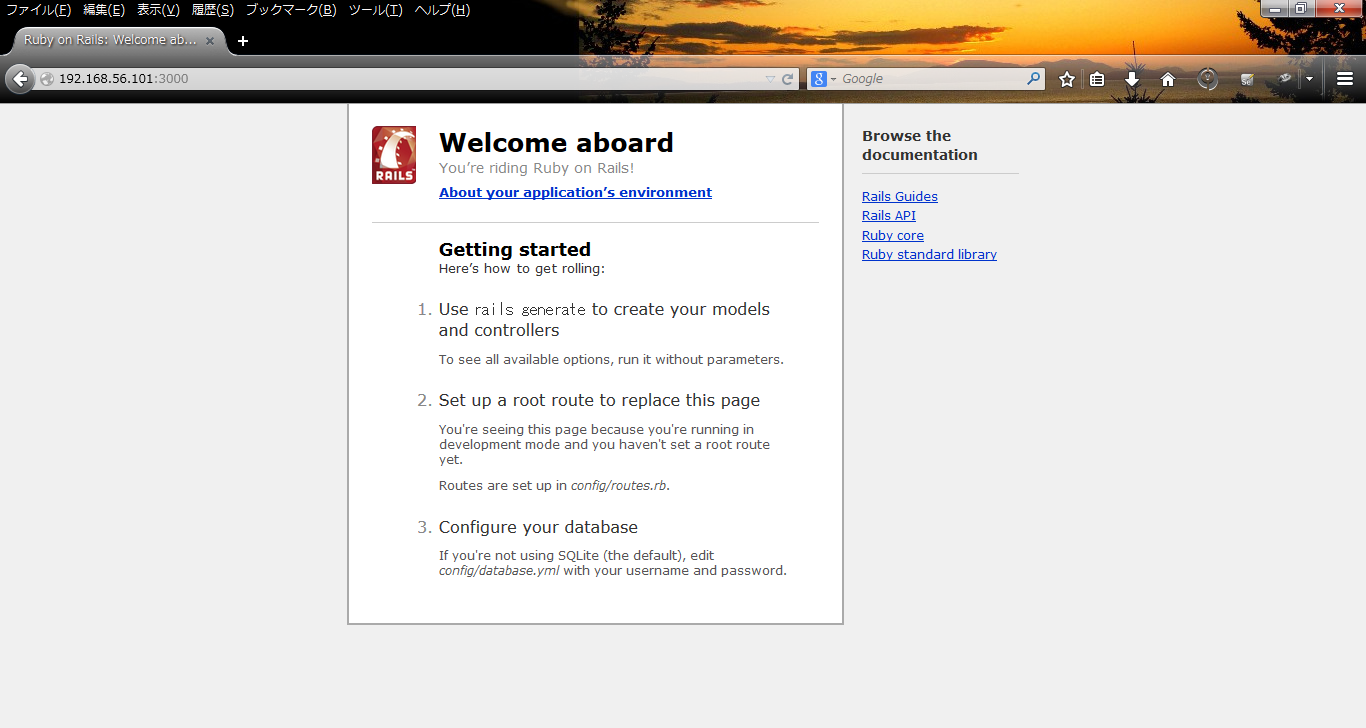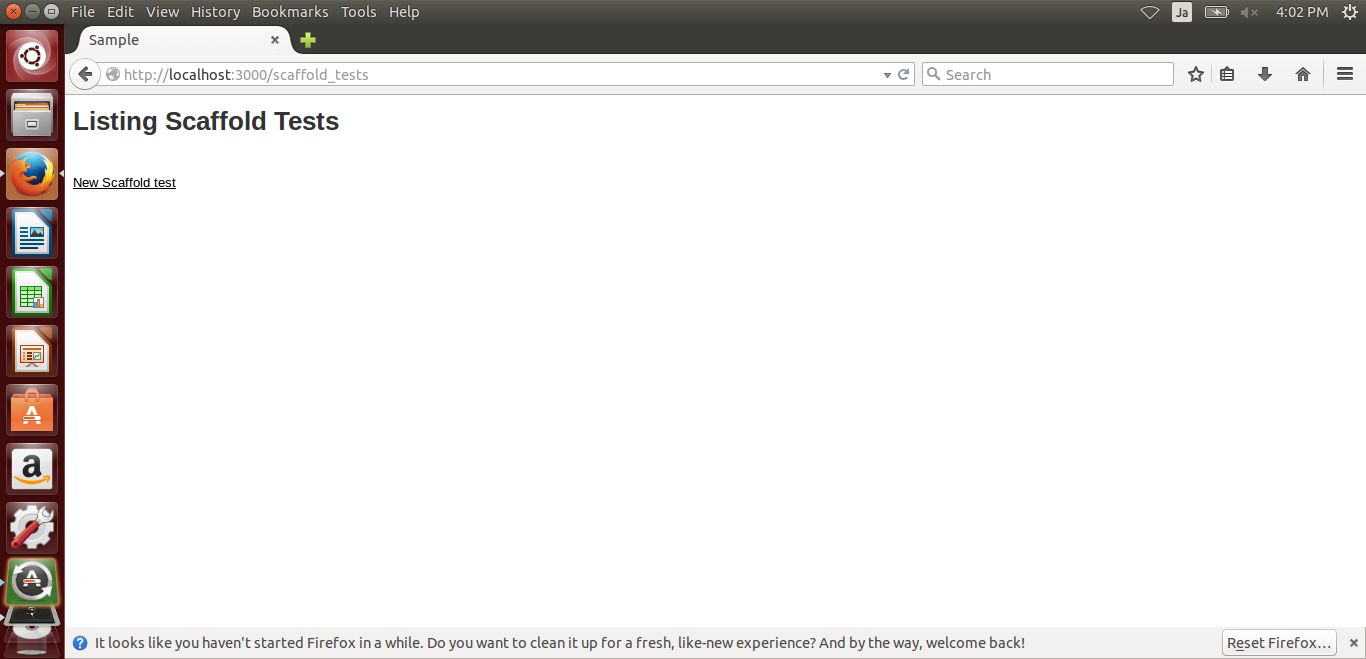Hello World from OSS Silicon Valley
HowToUse/RubyOnRails/4.1
_ Prerequisite
- Ubuntu Server (You can refer Overall/UbuntuServer)
- RVM (You can refer Overall/RVM)
_ Install&Setup
- Step.1
- Check if the rails has already been installed.
$ rails --version
- Step.2
- If the rails has not been installed yet, execute the following command
$ gem install rails
_ HowToUse
_ Create new application
- Step.1
- Create new application.
$ rails new <Application Name>
Step.2| Open the Gemfile and append the following lines.
$ vi Gemfile
gem ‘execjs’ gem ‘therubyracer’
$ bundle install
- Step.3
- Launch application.
$ cd <Application Name> $ rails server
- Step.4
- Access the following page.
http://localhost:3000/
When you are setting portforwarding with rails4.2, localhost doesn't work by default. If you want to do port-forwarding, put the following option.
$ rails start -b 0.0.0.0
_ Create sample program with Scaffold
- Step.1
- Create objects withs scaffold.
$ rails generate scaffold <Object Name>
(Example)$ rails generate scaffold TestObject name:string
- Step.2
- Prepare database.
$ rake db:migrate
- Step.3
- Launch the server and access http://<IP address>:3000/<Object Name>
Now you have a page which maintains data stored in Sqlite DB.
_ Create Say Hello program
- Step.1
- Create controller and view files.
$ rails generate controller <Controller Name> <Method(View)> <Method(View)>
(Example)$ rails generate controller Say hello goodbye
- Step.2
- Access the following page.
http://localhost:3000/say/hello/
#ref(): File not found: "CreateApplication_fig2.png" at page "HowToUse/RubyOnRails/4.1"
_ Get data from RESTful service
- Step.1
- Edit controller.
$ vi app/controller/<Controller file>
require 'open-uri'
require 'json'
res = open('<URL>')
code, message = res.status
if code == '200'
@result = JSON.parse(res.read)
end
- Step.2
- Put it to view file.
$ vi app/view/<View file>
<table> <% @result.each do |data| %> <tr> <td><%= data['<Key#1>'] %></td> <td><%= data['<Key#2>'] %></td> </tr> <% end %> </table>
_ Change table structures
- Step.1
- Create migration script
$ rails g migration <Migration Script Name>
(Example)
$ rails g migration AddColumnUsers
- Step.2
- Edit migration script.
$ vi db/migrate/<Migration Script File Name>
(Example - change column)
$ rails g migration db/migrate/20150927000024_add_column_workorders.rb
class AddColumnWorkorders < ActiveRecord::Migration
def change
add_column :<table name>, :<column name>, :<data type>
remove_column :<table name>, :<column name>
end
end
(Example - add foreign key)
class AddForeignKeyStatements < ActiveRecord::Migration
def change
add_foreign_key :<referring table name>, :<referred table name>
end
end
If you set "statements" as referring table, and "calendars" as refered table, then your calendar_id in statements table will be set for foreign_key.
(Example - remove foreign key)
class RemoveForeignKeyStatements < ActiveRecord::Migration
def change
remove_foreign_key :<referring table name>, :<referred table name>
end
end
- Step.3
- Setup database
$ rake db:create $ rake db:migrate
- Step.4
- Edit index.html.erb
$ vi app/views/<table>/index.html.erb
- Step.5
- Edit _form.html.erb
$ vi app/views/<table>/_form.html.erb
<%= f.label :<column> %> <%= f.text_field :<column> %>
- Step.6
- Edit conroller. After Rails is version up to 4.x, we can't use "attr_accessible", so we need to define as below instead.
$ vi app/controller/<table name>_controller.rb
def create attr = params.require(:<table name>).permit(:<column name>) @<table name> = <table name>.new(attr)
_ DB Migration
(Initilization)
$ rake db:migrate
(Rollback)
$ rake db:rollback
(DB Dump)
$ rake db:schema:dump
(Drop Database)
$ rake db:drop
(Load Dump file)
$ rake db:setup
(Reset DB)
$ rake db:reset
This is equivalent to "rake db:drop" with "rake db:setup".
_ Testing
- Step.1
- Prepare test script.
default script)
require 'test_helper' class <Class Name>ControllerTest < ActionController::TestCase # test "the truth" do # assert true # end end
- Step.2
- Prepare test environment.
$ rake db:test:prepare
- Step.3
- Execute test script.
$ rake test
_ Author
S.Yatsuzuka

